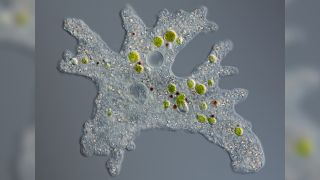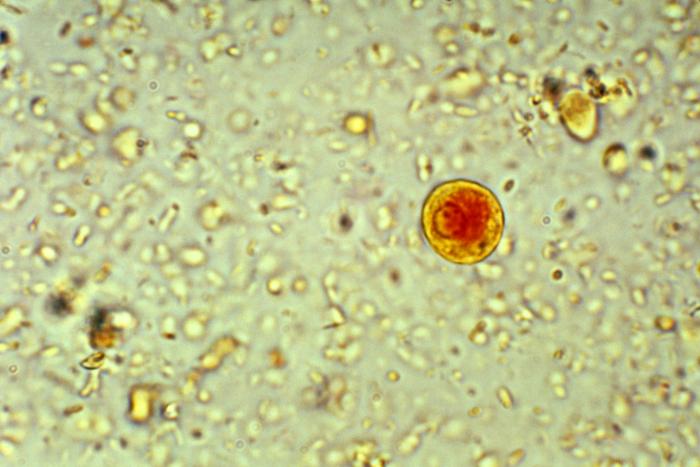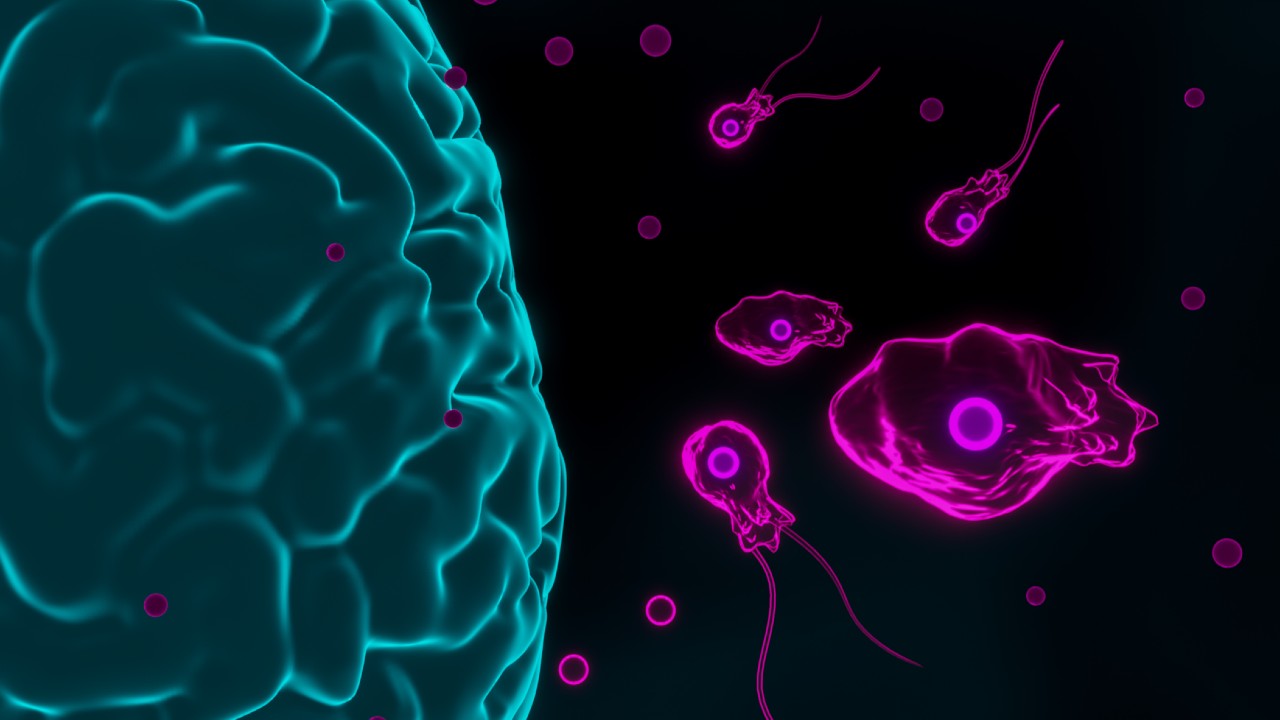In Amoeba That Function Like Âfalse Feet to Allow the Organism to Move and Feed Are Called
What is an amoeba?

"Amoeba" is a term that describes a simple eukaryotic organism that moves in a characteristic crawling fashion. However, a comparison of the genetic content of the various amoebas shows that these organisms are not necessarily closely related to each other.
What does an amoeba look like?
All living organisms can be broadly divided into two groups — prokaryotes and eukaryotes — which are distinguished by the relative complexity of their cells. Eukaryotes are highly organized unicellular or multicellular organisms, such as animals and plants. Prokaryotes, on the other hand, are basic single-celled organisms, such as bacteria and archaea.
Related: Strange single-celled life-form has a truly bizarre genome
Amoebas are eukaryotes. Their single cells, like those of other eukaryotes, possess certain characteristic features: Their cellular contents are enclosed within a cell membrane, and their DNA is packaged into a central cellular compartment called the nucleus, according to a 2014 report published in the journal BMC Biology (opens in new tab). In addition, they contain specialized structures called organelles, which perform a range of cellular functions including energy production and protein transport.
Most of these organelles are common to all eukaryotic cells, but there are a few exceptions. For example, the parasitic amoebas Entamoeba histolytica, which cause amoebic dysentery in humans, do not have the golgi apparatus, the organelle responsible for modifying and transporting proteins, according to a 2005 study published in The Journal of Biological Chemistry (opens in new tab). Researchers found that E. histolytica instead contain golgi-like compartments or vesicles — small fluid-filled pouches — that execute similar functions.
There are also amoebas that don't have mitochondria, the organelle responsible for generating cellular energy, because they live in environments lacking in oxygen, or "anoxic conditions," Sutherland Maciver, a reader in the department of biomedical sciences at the University of Edinburgh, told Live Science.
According to a 2014 review published in the journal Biochemie (opens in new tab), these organisms without mitochondria can contain organelles called hydrogenosomes or mitosomes, which are related to mitochondria but are thought to be highly altered versions of the organelle. This is the case for E. histolytica and the free-living amoeba Mastigamoeba balamuthi, which doesn't depend on other organisms for survival.
How does an amoeba move?
Structurally, amoebas closely resemble the cells of higher organisms. "They are like our cells, and in fact, when they are moving they look very much like our white blood cells," Maciver said. (White blood cells are immune cells that help defend the body against disease.)
Like our white blood cells, amoebas move using pseudopodia, which translates to "false feet" in Latin. These short-lived, outward projections of the cytoplasm — the semifluid material inside the cell membrane — help amoebas to grip a surface and propel themselves forward. As the pseudopodium moves out along a surface in one direction, the back end of the amoeba contracts, Maciver said.
"As it contracts, it does two things," he said. "The contraction pushes the cytoplasm forward to fill the expanding pseudopod, but the contraction also pulls up adhesions at the back end of the cell." Maciver describes these adhesions between an amoeba and the surface on which it moves as physical molecular adhesions, which are constantly formed at the front end and broken at the back. This movement, using pseudopodia, is a characteristic that unites various amoebas and distinguishes them from other protists — simple eukaryotic organisms like amoebas that are not plants, animals or fungi.
There are four different types of pseudopodia seen among amoebas: filopodia, lobopodia, rhizopodia and axopodia, according to Human Parasitology (opens in new tab) (Academic Press/Elsevier, 2019). The most common form of parasitic amoebas have lobopodia, which are broad, blunt cytoplasmic projections, while filopodia are thin, thread-like projections.
Rhizopodia, also known as reticulopodia, are thin filament-like projections that mesh together, and axopodia are rigid and strengthened by an array of microtubular structures called axonemes, according to Ecology and Classification of Northern American Freshwater Invertebrates (opens in new tab) (Academic Press, 2001). Other pseudopods are supported by structural tube-shaped elements known as microtubules, which are responsible for executing cell movements.
Related: Robert Hooke: English scientist who discovered the cell
Amoebas can also use their pseudopodia to feed. A 1995 report, published in the journal Applied and Environmental Microbiology (opens in new tab), gives the example of the soil-dwelling amoeba Acanthamoeba castellanii, which ingests both solids and liquids using its pseudopodia. The process of ingesting solid material is called phagocytosis, and the process of engulfing drops of liquid is known as pinocytosis, also known as cell drinking, according to Dosage Form Design Considerations (opens in new tab) (Academic Press/Elsevier, 2018).
"Most of the known amoebae eat bacteria," Maciver told Live Science. He explained that amoebas have receptors on their cell surface that bind to bacteria, which are then taken into amoebas by phagocytosis, usually at the rear of the cell.
In the case of giant amoebas, such as Amoeba proteus, the process of phagocytosis is slightly different, according to Maciver. Giant amoebae engulf their prey "by the willful gathering of pseudopods around the bacteria." In both cases, as the bacteria is drawn in, the cell membrane that surrounds it pinches off to form an intra-cellular compartment called the vacuole.

How are amoebas classified?
For centuries, the various systems of classifying organisms, including amoebas, were based on similarities in observable characteristics and morphology. "There isn't actually a coherent group of organisms called the amoebae," Maciver said. "Rather, amoebae are any protozoan cells that move by crawling." (The term "protozoa" refers to a subset of protists, which again are simple eukaryotic organisms that are not plants, animals or fungi, Live Science previously reported.)
Historically, amoebas were classified together in a single taxonomic group called Sarcodina, distinguished by their use of pseudopodia. Sarcodina amoebas were then subdivided based on the specific type of pseudopodia they used, according to a 2008 article published in the journal Protistology (opens in new tab). However, this system of classification didn't capture the evolutionary relationships between the various amoebas — it was not a family tree, so to speak.
Molecular phylogenetics changed the course of taxonomic classification for eukaryotes. By comparing the similarities and differences in particular DNA sequences within organisms, scientists were able discern how closely related they were, according to a 2020 review in the journal Trends in Ecology & Evolution (opens in new tab).
Early analyses compared the DNA sequences that encode part of the ribosome, the site of protein synthesis in a cell; specifically, scientists looked at the genes for the so-called 18S subunit of ribosomes, or "SSU rDNA." Based on the analyses of SSU rDNA and other DNA sequences, eukaryotic organisms are now organized in a manner that better represents their evolutionary relationships — the phylogenetic tree, according to the 2008 Protistology article.
Each lineage in a phylogenetic tree is depicted by a branched structure. In this system, the first levels are known as "supergroups." Fabien Burki, author of a 2014 review article published in the journal Cold Spring Harbor Perspectives in Biology, (opens in new tab) described these supergroups as the "building blocks" of the tree.
Burki listed five supergroups for eukaryotic organisms: Ophiskontha, Amoebozoa, Excavata, Archaeplastida and SAR, which includes three subgroups named Stramenopiles, Alveolata and Rhizaria. Animals and fungi are in the group Ophiskontha. Amoeboid protists and some parasitic lineages that lack mitochondria are part of Amoebozoa. Together, Ophiskontha and Amoebozoa form a larger supergroup called Amorphea, according to the review in the journal Trends in Ecology & Evolution.
Heterotrophic protists — organisms that take in nutrients from other organisms — are part of Excavata, while plants and most other photosynthetic organisms are part of Archaeplastida, according to The Encyclopedia of Evolutionary Biology (opens in new tab) (Academic Press/Elsevier, 2016).
"If you look at the great diversity of the protists, you can see that there are amoebae in virtually all the groups," Maciver said. "There's even an amoeboid organism within the brown algae [Labyrinthula]." Most amoebas are present within the Amoebozoa group, though, Maciver said. In addition, he noted that amoebas are also present within Rhizaria and Excavata. Nucleariids, a group of amoebae with filopodia, belong to the Opisthokonta supergroup, for example, and Labyrinthulids fit within the Stramenopiles.
Why are amoebas important?

Amoebas are known to cause a range of human diseases. Amebiasis, or amoebic dysentery, is an infection caused by E. histolytica, a human intestinal parasite, according to the Centers for Disease Control and Prevention (opens in new tab) (CDC). According to the medical database StatPearls (opens in new tab), E. histolytica can invade the colon wall and cause colitis, where the inner lining of the colon becomes inflamed, and the parasite can cause severe diarrhea and dysentery.
Though E. histolytica infections can occur anywhere in the world, it is most common in tropical regions that have substandard sanitation systems and crowded conditions.
Contact lens wearers are potentially at risk of a rare infection of the cornea called Acanthamoeba keratitis. According to the CDC (opens in new tab), species in the Acanthamoeba genus are free-living and are commonly found in soil, air and water. Poor contact lens hygiene practices, such as improper storage, handling and disinfection or swimming with lenses, are some of the risk factors for the disease, the CDC states. Contact lens users can reduce their risk of infection by wearing and cleaning their lenses as prescribed by their eye care provider, and removing their lenses before any activity involving contact with water, including showering, using a hot tub or swimming.
While the initial symptoms include redness, itchiness and blurred vision, if left untreated the infection can cause severe pain and lead to vision loss, according to the CDC.
Amoebas also cause different infections of the brain. Naegleria fowleri , which has been dubbed "the brain-eating amoeba," causes primary amoebic meningoencephalitis (PAM). Though the disease is rare, it is almost always fatal, according to the CDC (opens in new tab). Early symptoms include fever and vomiting, and the disease ultimately progresses to more severe symptoms such as hallucinations and coma. N. fowleri is present in warm freshwater bodies such as hot springs, lakes and rivers, or in poorly chlorinated swimming pools or contaminated, hot tap water. These amoebas enter from the nose and travel to the brain. However, the infection can't be contracted by swallowing water, according to the CDC.
Another amoeba, Balamuthia mandrillaris, can cause a brain infection known as granulomatous amoebic encephalitis (GAE). Balamuthia infections are rare but are often fatal. Current estimates suggest that the infection has a death rate of 90%, the CDC states (opens in new tab).
Early symptoms include headaches, nausea and low-grade fever, partial paralysis, seizures and speech difficulties. B. mandrillaris is found in the soil and can enter the body through open wounds or when people breathe in contaminated dust, according to the CDC. Since the amoeba was discovered in the 1980s, about 200 cases of the infection have been reported worldwide; this includes more than 100 confirmed cases in the U.S.
Amoebas can also play host to bacteria that are pathogenic to humans, and help those bacteria spread. Bacterial pathogens, such as Legionella, which can cause pneumonia- and flu-like illnesses, can resist digestion when consumed by amoebas, according to a 2018 report in the journal Front Cell Infection Microbiology (opens in new tab). Instead, the bacteria are released intact from vacuoles into an amoeba's cytoplasm, where they proliferate inside the cell. In such cases, bacteria can become resistant to treatments designed to control their numbers, including chlorine treatment of water.
Maciver cites the example of cooling towers as a place where both amoebas and these bacteria can grow. Cooling towers tend to expel water droplets, which passersby can breathe in. "What's known to happen on many occasions, is that we breathe in a droplet of water containing an amoeba that is full of these pathogens [Legionella]," he said. If bacteria enter the body of an immunocompromised individual in such a manner, they can ultimately infect macrophages, one of the immune system's many defensive cells.
"A macrophage not only looks like an amoeba, its biochemical pathways and cell biology are quite similar," Maciver said. "So the same programmed events that allow the bacteria to escape the amoeba now operate to allow Legionella to escape the macrophage."
Apart from their roles in human disease, amoebas are also an important part of the soil ecosystem. Amoebas prey on harmful bacteria and regulate their population in the soil, according to a 2021 review in the journal Applied and Environmental Microbiology (opens in new tab).
Amoebas are also important for recycling nutrients in the soil. According to Maciver, when nutrients become available they are taken up by bacteria, which "effectively lock up all the nutrients in bacterial mass." When bacteria are consumed, nutrients are released back into the soil. "If you have a cycle whereby amoeba eat bacteria, the overall effect is to increase nutrient availability for plants," Maciver said.
Additional resources and readings
- The Amoeba in the Room: Lives of the Microbes (opens in new tab) explores the incredible diversity of the microbial world.
- Learn more about different species of protist in Protists: Algae, Amoebas, Plankton, and Other Protists (A Class of Their Own). (opens in new tab)
- Read about the many microbes that live inside our bodies in Ed Yong's I Contain Multitudes: The Microbes Within Us and a Grander View of Life (opens in new tab).
Bibliography
Acharya, P. C., Fernandes, C., Mallik, S., Mishra, B., & Tekade, R. K. (2018). Physiologic Factors Related to Drug Absorption. In Dosage form design considerations (Vol. i, pp. 117–147). chapter, Academic Press/Elsevier.
Avery, S. V., Harwood, J. L., & Lloyd, D. (1995). Quantification and characterization of phagocytosis in the soil amoeba Acanthamoeba castellanii by flow cytometry. Applied and Environmental Microbiology, 61(3), 1124–1132. https://doi.org/https://www.ncbi.nlm.nih.gov/pmc/articles/PMC1388394/pdf/hw1124.pdf (opens in new tab)
Baum, D. A., & Baum, B. (2014). An inside-out origin for the eukaryotic cell. BMC Biology, 12(1). https://doi.org/10.1186/s12915-014-0076-2 (opens in new tab)
Bogitsh, B. J., Carter, C. E., & Oeltmann, T. N. (2019). General Characteristics of the Euprotista (Protozoa). In Human parasitology (fifth edition) (5th ed.). chapter, Academic Press.
Bredeston, L. M., Caffaro, C. E., Samuelson, J., & Hirschberg, C. B. (2005). Golgi and endoplasmic reticulum functions take place in different subcellular compartments of Entamoeba histolytica. Journal of Biological Chemistry, 280(37), 32168–32176. https://doi.org/10.1074/jbc.m507035200 (opens in new tab)
Burki, F. (2014). The Eukaryotic Tree of life from a global phylogenomic perspective. Cold Spring Harbor Perspectives in Biology, 6(5). https://doi.org/10.1101/cshperspect.a016147 (opens in new tab)
Burki, F., Roger, A. J., Brown, M. W., & Simpson, A. G. B. (2019). The New Tree of Eukaryotes. Trends in Ecology & Evolution, 35(1), 43–55. https://doi.org/10.1016/j.tree.2019.08.008 (opens in new tab)
Centers for Disease Control and Prevention. (2010, November 2). Acanthamoeba keratitis FAQs. Centers for Disease Control and Prevention. Retrieved January 28, 2022, from https://www.cdc.gov/parasites/acanthamoeba/gen_info/acanthamoeba_keratitis.html (opens in new tab)
Centers for Disease Control and Prevention. (2020, June 2). Balamuthia mandrillaris - Illness & symptoms. Centers for Disease Control and Prevention. Retrieved January 28, 2022, from https://www.cdc.gov/parasites/balamuthia/illness.html (opens in new tab)
Centers for Disease Control and Prevention. (2021, December 3). Parasites - amebiasis. Centers for Disease Control and Prevention. Retrieved January 28, 2022, from https://www.cdc.gov/parasites/amebiasis/index.html (opens in new tab)
Chou, A., & Austin, R. L. (2021, April 25). Entamoeba histolytica. StatPearls [Internet]. Retrieved January 28, 2022, from https://www.ncbi.nlm.nih.gov/books/NBK557718/ (opens in new tab)
Makiuchi, T., & Nozaki, T. (2014). Highly divergent mitochondrion-related organelles in anaerobic parasitic protozoa. Biochimie, 100, 3–17. https://doi.org/10.1016/j.biochi.2013.11.018 (opens in new tab)
McCourt, R. (2016). Archaeplastida: Diversification of Red Algae and the Green Plant Lineage. In Encyclopedia of evolutionary biology (pp. 101–106). entry, Elsevier, Academic Press. https://www.sciencedirect.com/science/article/pii/B9780128000496002547 (opens in new tab)
Oliva, G., Sahr, T., & Buchrieser, C. (2018). The life cycle of L. Pneumophila: Cellular differentiation is linked to virulence and metabolism. Frontiers in Cellular and Infection Microbiology, 8. https://doi.org/10.3389/fcimb.2018.00003 (opens in new tab)
Pawlowski, J. (2008). The twilight of Sarcodina: a molecular perspective on the polyphyletic origin of amoeboid protists. Protistology, 281–302. https://doi.org/http://www.zin.ru/journals/protistology/num5_4/pawlowski.pdf (opens in new tab)
Shi, Y., Queller, D. C., Tian, Y., Zhang, S., Yan, Q., He, Z., He, Z., Wu, C., Wang, C., & Shu, L. (2021). The ecology and evolution of amoeba-bacterium interactions. Applied and Environmental Microbiology, 87(2). https://doi.org/10.1128/aem.01866-20 (opens in new tab)
Editor's note: This article was last updated on Jan. 28, 2022 by Live Science staff writer Nicoletta Lanese.
Originally published on Live Science.
Source: https://www.livescience.com/54281-amoeba-definition.html
0 Response to "In Amoeba That Function Like Âfalse Feet to Allow the Organism to Move and Feed Are Called"
Post a Comment